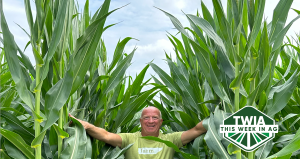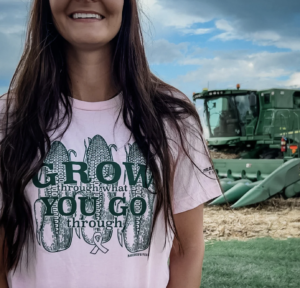#Harvest23 is in full swing. You probably have a sense of what farmers are currently doing. But what are farmers currently thinking about? Well, at this time of the year… A LOT!
Harvest logistics. Just as they do for planting, farmers prepare detailed plans for harvest. The two are carefully intertwined. Crop selection, varietal selection, field location and planting dates play a huge role in the “picking order” of what fields are harvested when. Field conditions also play a big role. Fields notorious for having wet holes could be moved up or down the picking order, based on current and expected weather conditions. You’ll want to get those fields out of the way if it’s currently dry, or delay them if they are currently wet.
Contract obligations. If a farmer contracts corn for September delivery, for example, he needs to make sure he can deliver it. He’ll need to plan accordingly, perhaps delay harvesting other crops to fulfill the volume in that contract. Specialty crop growers routinely plan for flexibility. If you have a contract with a potato processor, they may call you on Monday and say they want your potatoes on Wednesday.
Bottlenecks at grain elevators. A huge component in harvest efficiency is getting the grain to the bin. Combines are highly productive at harvesting grain. But the trick is getting rid of it. With on-farm storage systems, grain handling capacity and proximity from the field to the bin site has a big impact. So does the moisture content of the grain. Most Midwest farmers harvest corn well above the 15% moisture content required for sale, so artificial drying is required. The higher the moisture content, the longer the process takes. And if you’re hauling grain to a commercial elevator, you likely won’t be the only one there. Expect wait times. And under certain conditions, elevators may close early, especially when they are handling mass quantities of wet corn. Farmers are constantly mindful of these potential bottlenecks and must manage them accordingly.
Daily maintenance. Combines and cotton pickers have lots of bearings, fluids, belts and chains that need serviced. Trucks, tractors and other equipment need tires and fluids checked, windows cleaned, and other service performed. All engines must be fueled daily, which often involves utilizing transfer tanks placed on pick-up trucks to haul diesel fuel to equipment in the field. All maintenance is usually performed in the morning prior to starting the day.
Breakdowns. It’s not a matter of if, but when. No matter how much preventative maintenance you do, or how new they are, combines especially are destined to require repairs. There are just too many moving parts. Phone numbers for their equipment dealer’s service manager and parts counter are on every farmer’s speed dial.
Yield results. These days most combines feature a yield monitor inside the cab that tracks in real time the crop yield. At any given spot in the field, you can see your yield. This can be a very fun tool, or a real downer. This yield data is then recorded and can be downloaded into a mapping software program to manage your operation.
Weather. Weather conditions can determine if you can harvest, where you can harvest (poorly drained fields vs. well drained soils) and what crop you can harvest. Morning dews can play havoc. Soybeans are finicky and may not be ready until noon, while cotton lint needs to be dry.
Markets. Farmers are always paying attention to the market. Are you selling directly out of the field, storing on-farm or hauling to commercial elevators? Prices, marketing plans and landlord agreements dictate these decisions.
Labor. The more land and equipment you have, the more labor you need. Combine operators, truck drivers and grain cart operators are a must. Someone needs to watch over on-farm grain handling systems. Parts runners are required. Tillage is often done right behind the combine. If you have livestock, they still need to be fed. Is there a final cutting of hay? Someone has to do that. Due to the nature of farming, some of this labor may be seasonal. Attracting, hiring, retaining and managing farm labor comes with many of the same challenges as any industry, and more.
Determining what to do next year. From the view inside the combine, farmers can see how crops look, where pests may be present, how weed control looks, where erosion is occurring, where tiling is needed, and much more, as they size this up with data from the yield monitor. They are deciding what crops to plant where, making crop input decisions (high yielding areas are managed differently than low yielding areas), tillage decisions, contemplating planting rates and dates and more. They keep asking, what can I do to make this field better.
Planning for next year. Soil tests, fertilizer applications, planting winter wheat and cover crops, tillage… these all occur in the fall in tandem with harvest.
Sadly, with so much going on in their heads, farm safety may not be at the top. Mix in long days, low light levels and heavy equipment, and it’s easy to see how accidents can occur.
Saturday is National Apple Day, as October is also National Apple Month. From red delicious to honey crisp to the 200 other varieties grown across the fruited plain, apples are America’s most popular fruit. Moreover, family-owned apple orchards are key drivers in the nearly $1 billion agritourism industry (which has tripled in the last 15 years). The average American consumes 26 pounds of apples in some form each year and eats 10 pounds of it as fresh fruit. The USA is the world’s second largest producer, behind China. Our 5,000 commercial farms produce 240 million bushels annually, with 1 of every 3 apples we pick being exported. Washington is by far the USA’s leading apple producer, growing nearly two-thirds of the crop. When you add output from Michigan and New York, these three states account for over 90% of US production. A member of the rose family, apple blossoms must be pollinated to produce fruit. This involves carrying pollen from the male part of the flower to the female part. While wind can play a role, the most valuable and effective pollinators are bees. Apple trees are not native to North America and were brought to our shores by settlers in the early 1600s. The fruit is thought to have been domesticated in central Asia, perhaps as long as 10,000 years ago. Yet the fruit’s true origins are as old as recorded history, as there is a famous story about a certain couple sharing an apple…
Next Thursday, Continuum Ag will be hosting their next TopSoil webinar. Their last guest must have set the bar pretty darn high, as next week they bring in someone who has literally changed the entire industry, Liz Hainey. She and host Mitchell Hora will be talking about regenerative agriculture. You can register here.
October is breast cancer awareness month. Our friend @AgWithEmma has banded together with other ag social media influencers in this video, joining Illinois-based John Deere dealer Prairie State Tractor and Rosebud’s Tees to raise money for those in the fight. Purchasing a My Crop Top (which you can do here) is a great way to show rural pride while helping fight breast cancer.
Related Posts

This Week in Ag #19
Rain makes grain. Those words are as old as farming itself. In the nation’s breadbasket – the three I states, which produce 42% of our corn and 37% of our soybeans – there’s concern over the lack of rain. That triggered a major movement in the grain market. Drought officially grips 100% of the I

Why Are Humic Substances Called Acids?
By Richard Lamar, PhD Senior Director of Humic Research Bio Huma Netics, Inc. We are accustomed to seeing humic substances (humic and fulvic) in dry/granular form, and we tend to think of acids as liquids. So why are humic and fulvic substances called acids? All substances, solid AND liquid, have a chemical makeup. An acid

This Week in Ag #71
Farmers are not fast forgetters. They have long memories. Past weather events, cultural practices, product usage, and marketing decisions often drive future decisions. With that, I’m guilty as charged. Last season, a straight-line wind caused major greensnap to a new corn hybrid, wrecking my goals. This made me take pause and return to some of the


